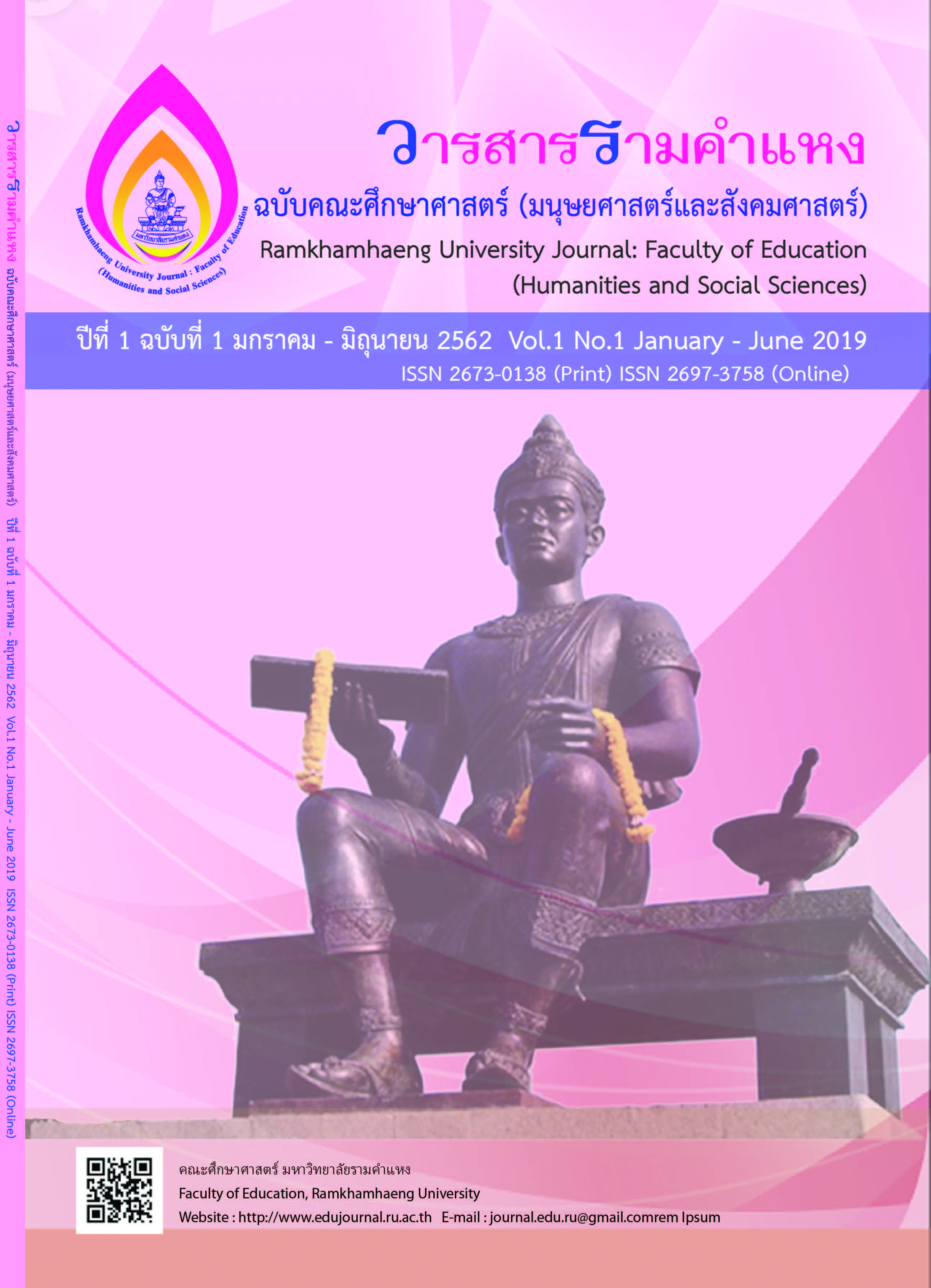A Comparison of the Analytical Ability in the Thai Subject of Matthayom Sueksa Three Students at Srinakharinwirot University Prasarnmit Demonstration School (Secondary) Using Problem-Based Learning and Traditional Method
Main Article Content
Abstract
In this thesis, the researcher compares the analytical reading ability in the Thai subject of selected matthayom sueksa three students at Srinakharinwirot University Prasarnmit Demonstration School (Secondary) (SUPDS-S) using problem-based learning and traditional methods, and also compares the analytical reading ability of students prior to the commencement and after the completion of the study using problem-based learning and traditional method.Using the simple random sampling method, the researcher selected a sample population consisting of two classrooms of matthayom sueksa three students at SUPDS-S enrolled in the first semester of the academic year 2017. In order to determine that the students in the first classroom were instructed using problem-based learning and those in the second classroom were taught utilizing traditional methods, the researcher had the students to draw lots.The research instruments consisted of lesson plans for problem-based learning and traditional methods in addition to a test for measuring analytical reading ability in Thai as tested by experts, who determined the test's index of congruence (IOC).Using techniques of descriptive statistics, the researcher analyzed the data collected in terms of mean (X) and standard deviation (S.D.) the dependent samples and the independent samples t tests were also employed by the researcher.Findings are indicated that in comparing analytical reading ability between the two groups, the researcher found that the group instructed through problem-based learning and the group taught by traditional methods did not exhibit differences. Both of the Students instructed through problem-based learning and traditional method displayed higher scores in the analytical reading of Thai after the completion of the study than prior to its commencement at the statistically significant level of .05.
Downloads
Article Details

This work is licensed under a Creative Commons Attribution-NonCommercial-NoDerivatives 4.0 International License.
ผู้ส่งบทความ (และคณะผู้วิจัยทุกคน) ตระหนักและปฎิบัติตามจริยธรรมการวิจัยอย่างเคร่งครัด ทั้งนี้บทความ เนื้อหา ข้อมูล ข้อความ ภาพ ตาราง แผนภาพ แผนผัง หรือข้อคิดเห็นใดๆ ที่ปรากฎในบทความ เป็นความคิดเห็นและความรับผิดชอบของผู้ส่งบทความ กองบรรณาธิการไม่จำเป็นต้องเห็นตามเสมอไป และไม่มีส่วนรับผิดชอบใดๆ โดยถือเป็นความรับผิดของของเจ้าของบทความเพียงผู้เดียว
References
ขวัญใจ นวลปาน. (2551).การเปรียบเทียบผลสัมฤทธิ์ทางการเรียนภาษาอังกฤษและเจตคติต่อการเรียนภาษาอังกฤษ ของนักเรียนประถมศึกษาปีที่ 1 ที่ได้รับการจัดการสอนแบบวัฏจักรการเรียนรู้ (MAT) กับการจัดการเรียนการ สอนแบบปกติ, วิทยานิพนธ์ครุศาสตรมหาบัณฑิต, มหาวิทยาลัยราชภัฏนครศรีธรรมราช.
จิราภรณ์ คงคุ้ม และชินวุฒิ วิจักษ์ประเสริฐ. (2553). การศึกษาความสามารถในการคิดวิเคราะห์ สังเคราะห์ และการคิดอย่างมีวิจารณญาณของนักศีกษาระดับประกาศนียบัตรวิชาชีพและระดับปริญญาตรีที่สอนโดยการจัดกิจกรรม แบบใช้ปัญหาเป็นฐานกับบรรยาย. สถาบันการเรียนรู้, สํานักวิจัยและบริการวิทยาศาตร์และเทคโนโลยี, มหาวิทยาลัยเทคโนโลยีพระจอมเกล้าธนบุรี.
ธนวัฒน์ คําเบ้าเมือง. (2553). การเปรียบเทียบผลสัมฤทธิ์ทางการเรียน ความสามารถในการคิดวิเคราะห์แรงจูงใจ ใฝ่สัมฤทธิ์ต่อการเรียนวิชาคณิตศาสตร์เรื่องรูปสี่เหลี่ยม ชั้นประถมศึกษาปีที่ 6 ระหว่างการจัดการเรียนรู้โดย ใช้ปัญหาเป็นฐาน (PBL) กับการจัดกิจกรรมการเรียนรู้แบบปกติ, วิทยานิพนธ์ ศึกษาศาสตรมหาบัณฑิต, มหาวิทยาลัยมหาสารคาม.
นพนภา อ๊อกด้วง. (2547). การเปรียบเทียบผลสัมฤทธิ์ทางการเรียน เรื่องคําและหน้าที่ของคําในภาษาไทยของนักเรียนชั้น มัธยมศึกษาปีที่ 2 ที่ได้รับการสอนโดยการเรียนแบบร่วมมือกันเทคนิค STAD กับการสอนแบบปกติ วิทยานิพนธ์ ศึกษาศาสตรมหาบัณฑิต, มหาวิทยาลัยศิลปากร.
ประกายมาศ ทองหมื่น. (2554). การใช้รูปแบบการเรียนรู้โดยใช้ปัญหาเป็นฐานเพื่อกระตุ้นการคิดวิเคราะห์ในการอ่าน วิทยานิพนธ์ศึกษาศาสตรมหาบัณฑิต, มหาวิทยาลัยเชียงใหม่พนิตพิมพ์ โศจิศิริกุล. (2552).
การใช้วิธีการเรียนการสอนแบบการใช้ปัญหาเป็นฐานเพื่อช่วยพัฒนาการเขียนความเรียง ภาษาอังกฤษให้กับนักศึกษาภาควิชาเทคโนโลยีสารสนเทศ กรณีศึกษา ณ มหาวิทยาลัยเทคโนโลยีพระจอมเกล้า ธนบุรี, วารสารมนุษยศาสตร์และสังคมศาสตร์ (มหาวิทยาลัยขอนแก่น), 26(1), 99-124.
มัณฑรา ธรรมบุศย์. (2545). การพัฒนาคุณภาพการเรียนรู้ โดยใช้ PBL (Problem-Based Learning), วารสารวิชาการ 5(2), 11-17.
วิเชียร ไชยบัง. (2558). โรงเรียนกบนอกกะลา: ภาคปาฏิหาริย์, บุรีรัมย์: เรียนนอกกะลา.สํานักงานเลขาธิการสภาการศึกษา. (2550). การจัดการเรียนรู้แบบใช้ปัญหาเป็นฐาน. กรุงเทพฯ: โรงพิมพ์ชุมนุมสหกรณ์ การเกษตรแห่งประเทศไทย.
สุนีย์ คล้ายนิล, ปรีชาญ เดชศรี และอัมพลิกา ประโมจนีย์. (2550). มองคุณภาพการศึกษาตะวันออกจากการประเมินผล นักเรียนนานาชาติ, กรุงเทพฯ: สถาบันส่งเสริมการสอนวิทยาศาสตร์และเทคโนโลยี.
สุวัฒน์ วิวัฒนานนท์. (2554). ทักษะการอ่านคิดวิเคราะห์และเขียน: ฉบับปรับปรุงตามหลักสูตรการศึกษาขั้นพื้นฐาน พุทธศักราช 2551. นนทบุรี: ซี.ซี. นอลลิดจ์ลิงค์.
สุวิทย์ มูลคํา และคณะ. (2554). การจัดกิจกรรมการเรียนรู้ที่เน้นการคิด, กรุงเทพฯ: สํานักพิมพ์ดวงกมล.
อัญชลี ชยานุวัชร. (2554). แนวคิดและกระบวนการการเรียนรู้โดยใช้ปัญหาเป็นฐาน (Problem-based Learning), นครศรีธรรมราช: โรงพิมพ์ดีชัย.
Bloom, B. S. (1956). Taxonomy of educational objectives, handbook 1: Cognitive domain. London: Longman.
Marzano, R. J. (2001). Designing a new taxonomy of educational objective. Calif. Corwin Press.


